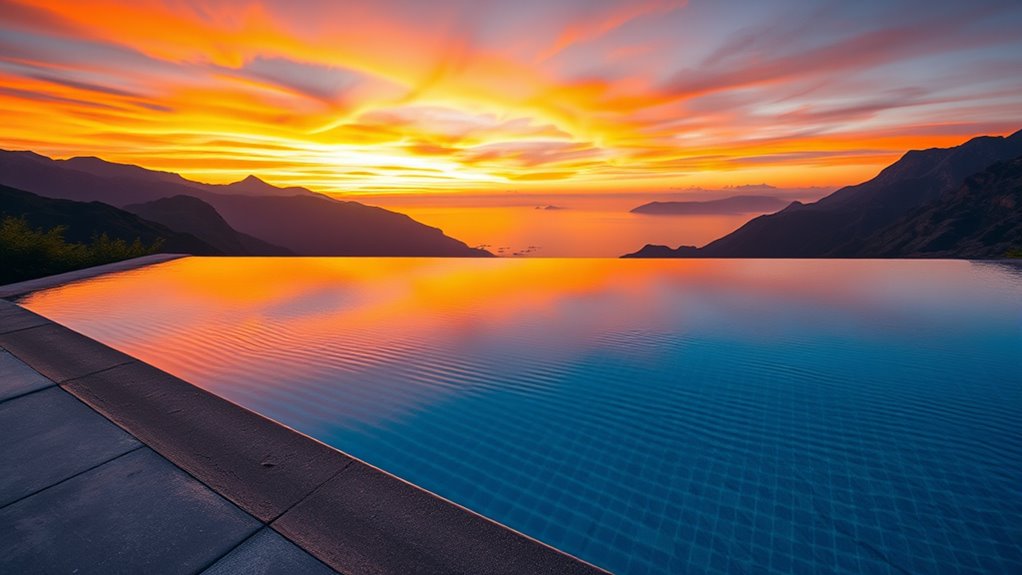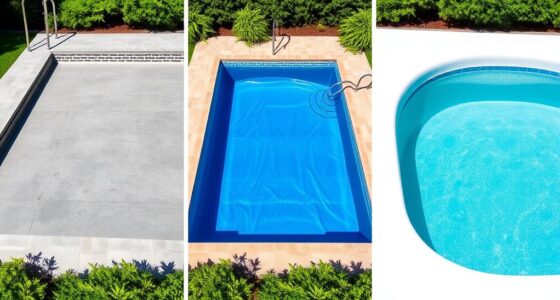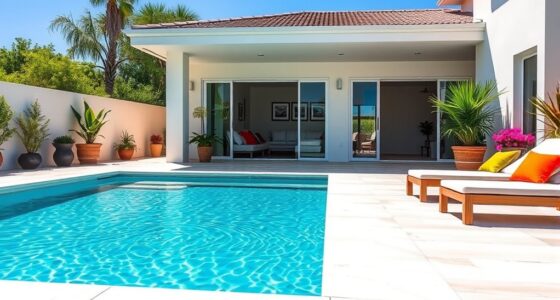Infinity-edge structures blend water seamlessly with the horizon through precise engineering and clever design. You need to focus on load distribution, support systems, and reinforcement to guarantee safety and durability. Material choice, waterproofing, and water pressure management play essential roles in maintaining structural integrity. It’s also imperative to follow safety standards and stay updated on innovative techniques. If you explore further, you’ll gain deeper insights into creating stunning, secure infinity-edge features.
Key Takeaways
- Precise edge alignment and hidden boundaries create seamless water-horizon illusions requiring accurate engineering.
- Structural supports like tension cables and reinforcements distribute loads and prevent deformation at stress zones.
- Material selection focuses on strength, durability, waterproofing, and compatibility with environmental conditions.
- Water pressure management involves calculating forces at various depths and designing drainage and waterproof systems.
- Regular inspection, maintenance, and safety measures ensure durability, structural integrity, and safety over time.
Understanding the Concept of Infinity-Edge Design
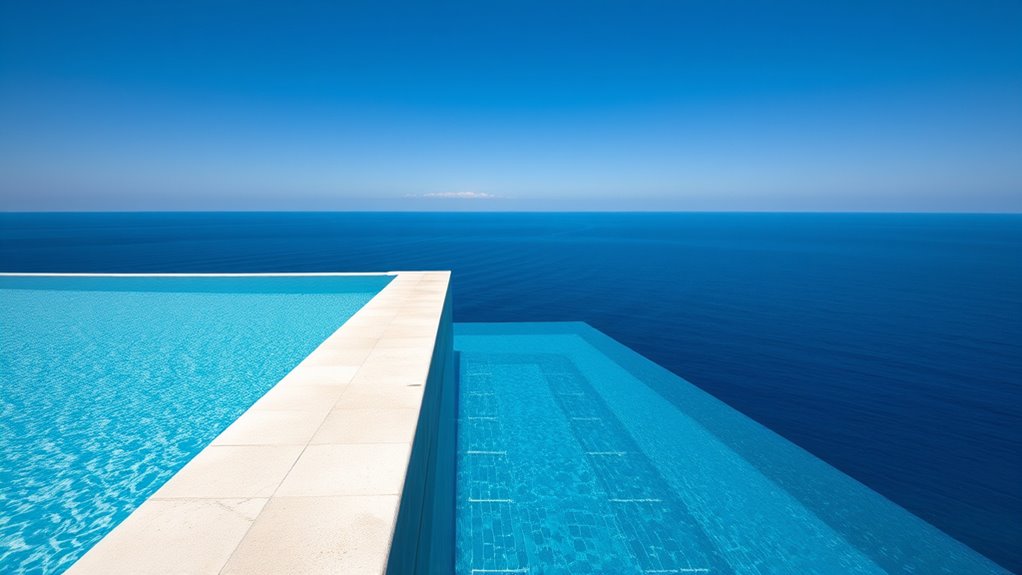
Have you ever wondered how some pools and glass walls seem to seamlessly blend into the horizon? That’s the magic of infinity-edge design. It creates the illusion that water extends endlessly, vanishing into the distance. You achieve this by positioning the edge of a pool or glass wall at the point where it visually aligns with the surrounding landscape or sky. The edge is often slightly lower or hidden, so your eye perceives no boundary. This design relies on precise engineering to ensure structural integrity while maintaining the illusion. The key is careful planning of the edge’s placement, height, and surrounding environment. Additionally, understanding the contrast ratio helps in selecting materials and lighting to enhance the visual effect. Proper structural engineering ensures the safety and durability of the design, especially when dealing with large spans and water pressure. Employing accurate measurements during planning is essential to achieve the perfect visual harmony. Modern collaboration tools are often employed to coordinate the complex engineering aspects across different teams and locations. When done correctly, you get a stunning visual effect that blurs the line between water and sky, offering a truly immersive experience.
Principles of Load Distribution in Infinity-Edge Structures

Understanding how loads transfer in infinity-edge structures helps guarantee stability and safety. You need to take into account support systems that evenly distribute forces and reduce stress concentration zones. By grasping these principles, you can design structures that effectively manage stress and maintain integrity under various loads. Additionally, incorporating exfoliating materials can enhance the durability and performance of the structure over time. Recognizing relationship dynamics can also be beneficial in designing structures that accommodate human interaction and environmental factors. Moreover, understanding nutritional profiles of related materials can inform the selection of components that contribute to structural resilience. Regular monitoring of cost variances can also help in optimizing material usage and maintaining budget accuracy. Developing a deep attention to detail can further improve the precision and safety of the engineering process.
Load Transfer Mechanics
How do infinity-edge structures effectively transfer loads to maintain their sleek, seamless appearance? You rely on carefully designed load transfer mechanics that direct forces from the edge inward through the structure’s core. The load from the water or glass surface is evenly distributed via tension cables, cantilevered supports, or internal reinforcement. These components absorb and redirect stresses, preventing distortion or sagging at the edge. You also utilize precise material placement to ensure forces are efficiently channeled to the foundation. This balanced load transfer maintains the clean, uninterrupted aesthetic while ensuring structural stability. Additionally, the use of sustainable building materials in construction can enhance the durability and eco-friendliness of infinity-edge structures. Properly designed load distribution strategies are essential for managing the complex forces involved and ensuring long-term performance. By understanding how forces move through the system, you can optimize design details that uphold both the visual appeal and safety of infinity-edge structures, especially by considering pressure management techniques to prevent overloads. Furthermore, incorporating structural analysis methods can help identify potential stress points before construction begins. Implementing regular maintenance protocols ensures sustained load transfer efficiency and structural integrity over time.
Structural Support Systems
Effective load distribution is fundamental to supporting the sleek, seamless appearance of infinity-edge structures. Your support system must evenly transfer forces across the entire edge, preventing stress buildup that could cause failure. To achieve this, you rely on various structural components working together. These include:
- Reinforced concrete beams to bear and spread loads
- Tension cables that help manage outward forces
- Support piers positioned strategically for stability
- Continuous load-bearing slabs for uniform force transfer
- Anchoring systems that secure the structure to its foundation
- Structural integrity is crucial for ensuring the durability of all support elements in infinity-edge designs. Proper integration of these components ensures that the structure can handle load distribution effectively, maintaining both safety and aesthetic appeal. Additionally, understanding the support system design principles helps optimize material use and enhances overall stability. Recognizing the importance of foundation stability is essential for long-term performance in these structures.
Understanding how these elements interact ensures your infinity edge remains both visually stunning and structurally sound. Proper design and integration of support systems are essential for safely managing the unique forces at play in these sleek, modern structures.
Stress Concentration Zones
Stress concentration zones are critical areas where forces become localized within an infinity-edge structure, often due to geometric features or support points. These zones experience higher stress levels, increasing the risk of material failure if not properly managed. Recognizing these zones helps you implement effective load distribution strategies. To minimize stress concentrations, you can use smooth progressions, reinforcement, or gradual geometric changes. Here’s a comparison of common features:
| Feature | Effect on Stress Concentration |
|---|---|
| Sharp corners | Increase localized stress |
| Rounded edges | Reduce stress concentration |
| Structural supports | Focus forces, create stress zones |
| Reinforcements | Distribute loads more evenly |
Understanding these factors allows you to optimize infinity-edge designs for safety and durability. Additionally, employing core personality traits insights can enhance team collaboration in engineering projects. Being aware of material properties is also crucial for selecting appropriate construction materials that can withstand these stress zones effectively.
Material Selection for Structural Integrity and Aesthetics
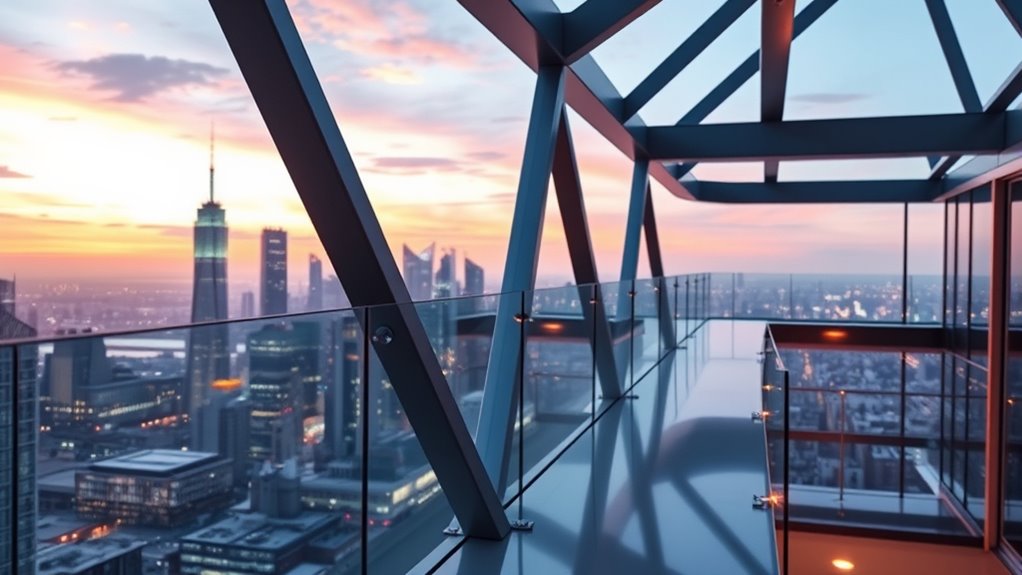
When selecting materials for a structure, you need to balance both strength and visual appeal to guarantee durability and aesthetic harmony. Choosing the right materials impacts not only the longevity but also the overall design aesthetic. Think about durability against environmental factors like weather and corrosion, especially for infinity edges exposed to water and elements. Material weight, ease of installation, and maintenance also matter, ensuring safety and longevity. Additionally, the visual texture and color should complement your design intent. Here are key factors to consider:
Balancing strength and aesthetics ensures durable, visually appealing, and resilient structures.
- Material strength and load-bearing capacity
- Resistance to corrosion and weathering
- Compatibility with aesthetic goals
- Ease of fabrication and installation
- Maintenance requirements over time. Incorporating AI-driven data analysis can help predict long-term material performance under various environmental conditions, ensuring optimal choices for durability and aesthetics. Utilizing advanced simulation tools can further assist in evaluating how materials perform in real-world scenarios, enhancing decision-making for complex structures. Considering material sustainability can also contribute to environmentally responsible design choices and long-term resilience.
Waterproofing Techniques for Infinity Pools and Edges

Choosing the right sealant is essential for ensuring your infinity pool remains watertight and durable. You also need effective drainage systems to prevent leaks and water damage. By understanding these key techniques, you can better protect your pool’s structure and longevity.
Sealant Selection Methods
Selecting the right sealant is crucial for guaranteeing waterproofing integrity in infinity pools and their edges. You need a sealant compatible with the pool’s materials, capable of withstanding water pressure, temperature fluctuations, and UV exposure. Consider the sealant’s flexibility to accommodate movement without cracking. Durability and long-term adhesion are essential to prevent leaks. Proper surface preparation ensures maximum bonding. Additionally, select sealants with proven waterproofing performance and chemical resistance. You should also evaluate ease of application and curing time to fit project timelines.
- Compatibility with pool materials (concrete, glass, tile)
- Flexibility and elastic properties
- Resistance to UV, chemicals, and temperature shifts
- Ease of application and curing process
- Long-term adhesion and durability
Drainage and Leak Prevention
Effective drainage and leak prevention are essential for maintaining the structural integrity of infinity pools and their edges. Proper waterproofing protects your investment from costly repairs and water damage. Use high-quality membranes and sealants to create a seamless barrier against leaks. Guarantee your drainage system efficiently channels excess water away, preventing pooling that can weaken the structure.
Consider the following to evoke confidence and peace of mind:
| Benefit | Key Technique | Result |
|---|---|---|
| Longevity | Durable waterproof membranes | Lasts for decades without issues |
| Safety | Proper slope design | Prevents water accumulation |
| Cost Savings | Regular maintenance checks | Avoids costly repairs |
| Peace of Mind | Reliable leak detection systems | Instant leak identification |
Structural Support Systems and Reinforcement Strategies

Have you ever wondered how buildings stay strong and stable under various loads? Structural support systems and reinforcement strategies are key to ensuring safety and durability. You’ll find that beams, columns, and load-bearing walls work together to distribute weight efficiently. Reinforcement techniques like steel rebar, carbon fiber wraps, and post-tensioning enhance structural integrity. Using advanced materials and innovative designs helps resist forces such as wind, seismic activity, and gravity. Proper placement and integration of these systems prevent deformation and failure. To deepen your understanding, consider these aspects:
- Load distribution methods
- Material selection and compatibility
- Reinforcement placement techniques
- Structural redundancy
- Connection details and joints
The Role of Glass and Transparent Barriers
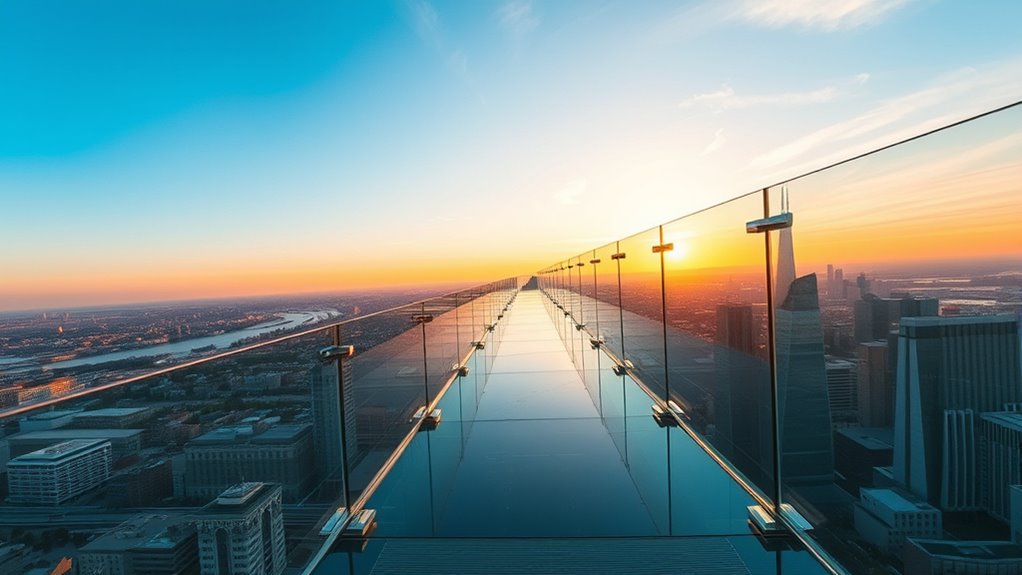
Glass and transparent barriers play a vital role in modern structural design by merging functionality with aesthetics. They create seamless views, making spaces feel open and connected to the environment. You’ll find them in infinity pools, observation decks, and building facades, where they provide safety without obstructing sightlines. Their strength depends on careful engineering, incorporating tempered or laminated glass to withstand wind, impact, and pressure. You need to contemplate factors like load distribution, support framing, and sealants to guarantee durability and safety. Effective use of transparent barriers not only enhances visual appeal but also maximizes natural light, reducing energy costs. When designed properly, glass and barriers become integral elements that elevate architectural beauty while maintaining structural integrity.
Calculating and Managing Water Pressure Effects
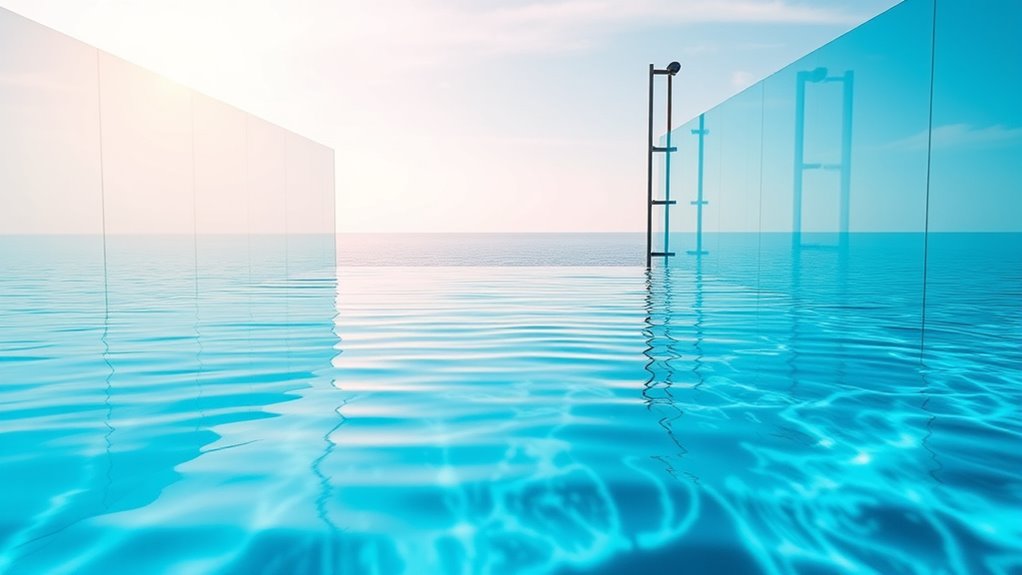
Water pressure exerted on structures increases with depth, making it essential to accurately calculate these forces to guarantee safety and stability. You need to understand how pressure varies and apply correct formulas to ensure your designs withstand these forces. Proper management involves selecting materials that resist water stress, incorporating drainage systems, and designing for load distribution. You must also consider dynamic effects like wave action or fluctuating water levels. Failing to account for water pressure can lead to structural failure or leaks. To deepen your understanding, consider these aspects:
- Hydrostatic pressure calculations
- Material selection for water resistance
- Reinforcement techniques
- Drainage and waterproofing strategies
- Impact of water level fluctuations
Foundation Design and Site Considerations
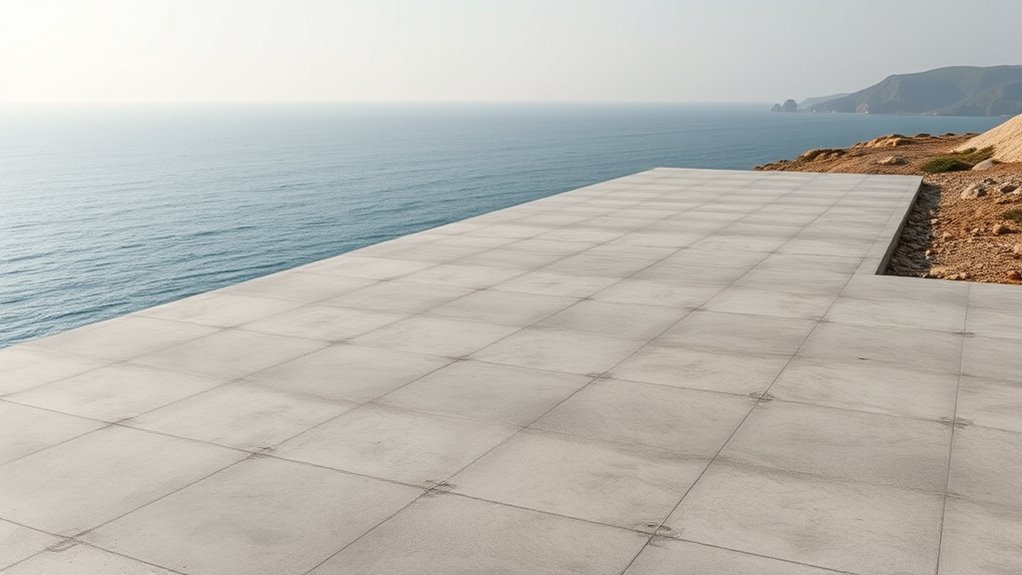
How do you guarantee a building’s stability from the ground up? The key lies in thoughtful foundation design and thorough site considerations. First, you assess the soil’s bearing capacity, ensuring it can support the structure’s weight without shifting or settling. You also evaluate groundwater levels, drainage, and potential for soil erosion, tailoring your foundation type accordingly—whether it’s slab, pier, or deep pile foundations. Site conditions like seismic activity or wind loads influence your choices, prompting the use of reinforcement or specialized materials. Proper excavation and preparation prevent future issues. By analyzing these factors early, you create a stable base that withstands environmental forces and minimizes movement, ensuring your infinity-edge structure remains secure and durable over time.
Safety Measures and Compliance Standards
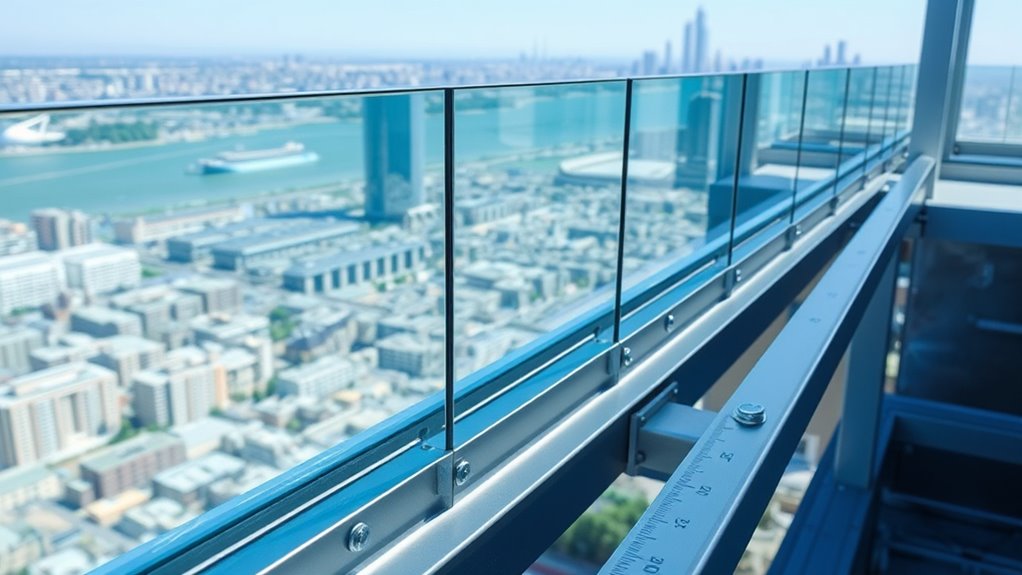
You need to understand building code regulations to guarantee your designs meet legal standards. Implementing proper safety protocols helps protect everyone who uses the structure. Regular inspections and maintenance are essential to keep safety measures effective over time.
Building Code Regulations
Have you ever wondered what guarantees a building’s safety and durability? Building code regulations set the standards you must follow to ensure structural integrity and safety. These codes specify materials, design practices, and construction procedures that comply with legal and safety requirements. They are regularly updated to reflect new technologies and safety insights. By adhering to these regulations, you help prevent failures and accidents, protecting occupants and the public. It’s your responsibility to understand and implement these standards during design and construction. Failing to comply can lead to legal issues, project delays, or unsafe structures. Staying informed about local codes ensures your project meets all safety standards and passes inspections smoothly.
- Material strength requirements
- Load-bearing capacity standards
- Fire safety and escape routes
- Wind and seismic resistance criteria
- Inspection and certification processes
Structural Safety Protocols
Ensuring structural safety requires implementing rigorous safety measures and adhering to strict compliance standards throughout the design and construction processes. You must incorporate safety protocols at every stage, from initial planning to final inspection. This includes conducting thorough risk assessments, ensuring proper load calculations, and selecting high-quality materials that meet industry standards. Adherence to building codes and regulations is essential to prevent failures and protect occupants. You should also enforce safety training for all personnel involved, emphasizing proper procedures and hazard awareness. Regularly reviewing safety protocols keeps your project aligned with evolving standards. By prioritizing these measures, you minimize risks, guarantee structural integrity, and comply with legal requirements—ultimately safeguarding lives and securing the longevity of your infinity-edge structure.
Inspection and Maintenance
Regular inspection and maintenance are essential to preserving structural safety and ensuring compliance with industry standards. You need to routinely check for signs of wear, corrosion, or damage that could compromise the infinity-edge structure’s integrity. Consistent maintenance prevents costly repairs and extends the lifespan of the installation. During inspections, verify anchoring systems, seals, and load-bearing components, and document findings for regulatory reviews. Adhering to safety measures reduces risks to personnel and visitors. Make sure to follow local codes and manufacturer guidelines to stay compliant.
- Conduct visual and instrumental inspections regularly
- Monitor for corrosion, cracks, and deformation
- Replace worn or damaged components promptly
- Maintain detailed inspection and repair records
- Train staff on safety protocols and standards
Innovations and Future Trends in Infinity-Edge Engineering
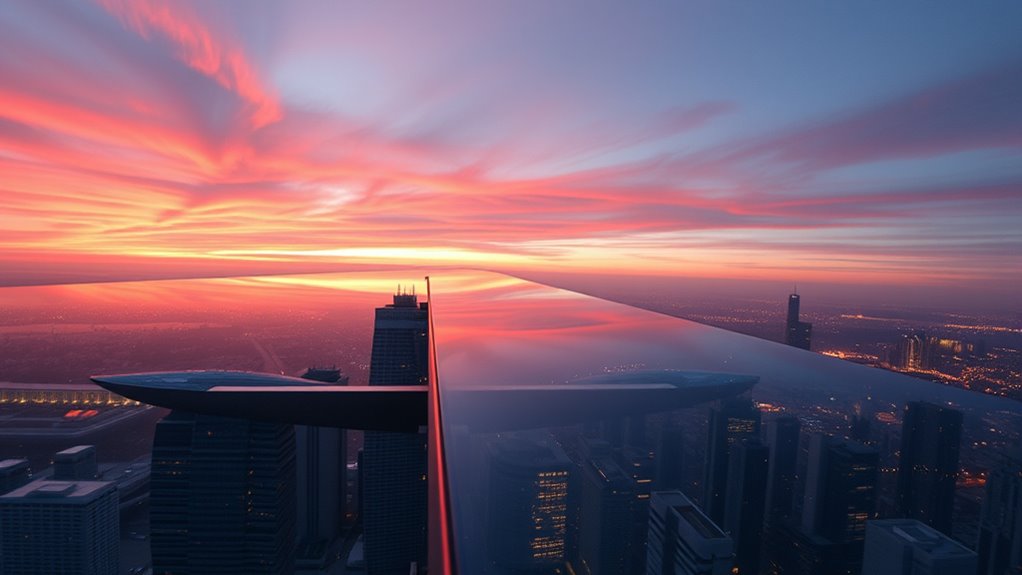
Innovations in infinity-edge engineering are transforming how we design and construct breathtaking visual effects in modern architecture. Advancements in materials like ultra-clear tempered glass and reinforced structural supports allow you to create safer, more seamless edges. New construction techniques, such as pre-fabricated modules and precision engineering, reduce installation time and enhance accuracy. Future trends focus on sustainability, integrating eco-friendly materials and energy-efficient systems to minimize environmental impact. Smart sensors and automation will enable real-time monitoring of edge stability and water levels, increasing safety and maintenance efficiency. As technology evolves, expect more dynamic, customizable infinity-edge designs that push creative boundaries while maintaining structural integrity. You’ll find yourself at the forefront of innovative design, shaping iconic, awe-inspiring structures for years to come.
Frequently Asked Questions
How Do Temperature Fluctuations Affect Infinity-Edge Structures?
Temperature fluctuations can notably impact infinity-edge structures by causing expansion and contraction of materials. When it gets hot, the materials expand, potentially stressing joints and causing cracks. In cold weather, they contract, which might lead to gaps or misalignment. You need to account for these changes during design, using flexible joints and choosing materials that can handle temperature shifts to maintain the structure’s integrity and aesthetic appeal over time.
What Are Common Maintenance Challenges for Infinity-Edge Pools?
You’ll face the wild challenge of keeping your infinity-edge pool pristine and functional. Constantly, you deal with water evaporation, which seems like a never-ending battle, and debris sneaks in like a stealthy intruder. You must regularly check the delicate glass-like edge for cracks or leaks and guarantee the water level stays perfect. It’s a relentless, high-stakes game demanding vigilance, patience, and expert maintenance to keep your stunning view flawless.
How Are Wind Loads Managed in Large Infinity-Edge Installations?
Managing wind loads in large infinity-edge installations is vital for safety and stability. You should analyze local wind conditions and incorporate this data into your structural design. Reinforce the edge structure with strong materials and consider wind barriers or screens to reduce impact. Regular inspections and maintenance guarantee these measures stay effective. By proactively addressing wind loads, you protect your pool and ensure it remains a stunning, safe feature.
What Are Cost Considerations for Different Infinity-Edge Materials?
Thinking about the cost of infinity-edge materials is like balancing on a tightrope—you want safety and style without breaking the bank. You’ll find that glass offers a sleek, modern look but can be pricey, while acrylic is budget-friendly but less durable. Consider installation, maintenance, and lifespan, as these factors influence overall costs. Choosing the right material depends on your budget and what you value most in your stunning edge feature.
How Do Local Regulations Influence Infinity-Edge Design Choices?
You need to take into account local regulations, as they directly impact your infinity-edge design choices. These rules dictate safety standards, barrier heights, and water retention measures, which can limit or shape your options. By understanding and complying with these regulations early, you avoid costly redesigns and delays. It’s essential to consult local authorities and incorporate their guidelines into your plan to ensure your infinity edge is both compliant and visually stunning.
Conclusion
Mastering infinity-edge structural engineering transforms dreams into breathtaking realities, pushing the boundaries of design and innovation. By understanding load distribution, selecting the right materials, and prioritizing safety, you can create stunning, seamless water features that captivate and inspire. Remember, your expertise has the power to turn a simple edge into a masterpiece that stands the test of time—truly an engineering marvel that defies limits and elevates aesthetics to celestial heights.
